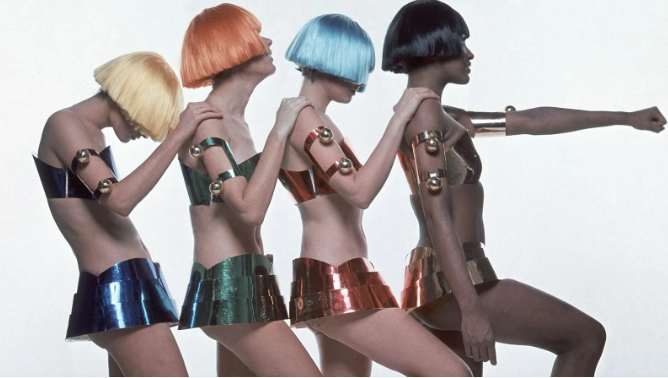Back to the Future: The Commercial Space Age and What It Means for Fashion
When the famous “one small step for man, one giant leap for mankind” was taken in 1969, no one could have predicted the cultural fever that the success of Apollo 11 would propel: from fashion, cars, interior design, to music—the 1960’s-70’s “Space Age” was everywhere. Today, our society is gearing up for another revival of such retrofuturism. What does this mean for fashion, culture, and the future?
Many dreamed of what the years ahead would look like— will we live on a new planet? Will we take rocketships as casually as we take commercial airplanes? To add on to this excitement, UFO sightings were the talk of the town inspiring even more questions about how the martian extraterrestrials dressed. Society needed a wardrobe to equip a new generation of dreamers. Fashion in this case also served as a vessel for American expansionism: everyone sought to display their readiness for the new age through futuristic clothes, so competitors would look on to Americans and think… are we prepared enough?
Enter Andre Courreges, a French fashion designer. He sought to encapsulate the new excitement and preparedness of the Western Space Race in his designs. Arguably one of the biggest turning points for Space Age fashion, his pivotal 1964 collection “Moon Girl” set the precedent for decades to come. High shine fabrics, bright white go-go boots, stiff A-line silhouettes, gender-role-defying trouser suits, helmets, miniskirts… Courreges incited rebellion while also preparing his models (nay, astronauts?) for the unknown cosmos ahead.
(Image from Daniella on Design)
Pierre Cardin also was pioneering the ready-to-wear fashion industry for a new generation. He employed futuristic use of silver vinyl in fashion, still seen heavily in styles today. Cardin’s designs were so culturally influential that NASA asked for his help in 1969 to assist in the design of their astronaut suits! Beyond Cardin, other designers like Paco Rabanne innovated with unique chainmail creations that seemed to equip models to be knighted space warriors.
Mary Quant, a female designer and leader of the “Chelsea Set” (a band of bohemian rebellious youth) was a force to be reckoned with. As the old norms of the British monarchy were crumbling before her very eyes, information, money, and trends became more accessible to the public. Quant broke down elitism by pioneering functionalism— nothing fussy, no frills— and also borrowed materials from menswear to manifest youthful rebellion against old, polite society through her designs.
(Image from BBC)
She will forever be known as one of the creators of the miniskirt. Where this style had only ever been worn through Americans’ television screens by Star Trek-esque sci-fi characters, Quant brought the rebellious, liberating, seductive allure of space into the modern woman’s wardrobe.
After this initial craze of “retrofuturism”, it had a quick turnaround time into the next era of 1990’s retrofuturism. In this new era, instead of with space travel, anxious excitement and fears about new technology became associated with the budding internet. The looming “Y2K”, hackers, machinery, and computers fueled fashions reflecting a similar mindset through steampunk and cyberpunk reminiscent styles. “The Matrix” movie and its associated fashions became synonymous with many of these escapist rebrandings of the original space age.
Fast forward to today, youth are feeling more stressful effects of election chaos, climate change, wildfires, gun violence, and uncertainty than ever before. They yearn for a better tomorrow, amplified but similar feelings to those same ones in the 1960’s with hopes and dreams for normalcy after World War II. Talks of human missions to Mars are the new moon landing dreams of our generation. With the new photos from the James Webb Space Telescope, we can see further into the past than ever before. Elon Musk’s SpaceX and other prominent billionaires promise that recreational space flight are in our future: Jeff Bezos and other prominent figures are already taking part in such travel. 2021 alone rivaled the amount of rocket activity as when the space race officially began in 1957.
(Image from HypeBae)
For fashion, retrofuturism has made its returned debut. On a technological scale, history’s first Metaverse Fashion Week was recently rolled out, along with respective Fashion NFTs taking the globe by storm. The incorporation of wearable technology has infiltrated our everyday wardrobes— from the more common Apple Watch to “smart belts” and “smart glasses”, our fashions reflect a more connected human. We’re also able to create advanced Earth-friendly fabrics like MYX mushroom leather.
In the designer’s eyes, these hopes and dreams for a better tomorrow are also reflected in their shows. The revived high demand of Andre Courreges’ pieces should be the first signal: a new subculture has begun to form around collecting his styles, with celebrities like Dua Lipa taking part. For her, she takes it one step further in her music; her album titled “Future Nostalgia” evokes imagery of Space Ages past. Additionally, the 2018 Moschino FW show was littered with mod dresses, Jackie Kennedy-esque pillbox hats where the show’s theme actually implied Jackie herself was an extraterrestrial. Or, take Chanel’s FW 2018/18 show that featured a 35m rocket that launched during the show. The models were equally decked in metallic prints, space blankets, and planet prints as they sashayed over a launch-pad style runway.
(Image from Elle)
In the “original” space age of the 1960’s up to now, it’s apparent that fashions and cultural crazes serve as a method of escapism and a reflection for a hope of a better tomorrow. Simply put, “retrofuturism is not necessarily about the fashions that emanated from a certain decade or designer, but rather about how the consumption of these fashions transformed the meaning of the future within the culture. Like most trends, it’s a cyclical chain reaction… it makes one wonder: what will we think of the “futuristic” fashion of today 20 years from now?” (L’Officiel).
Will we ever experience a cultural fever similar to that of the 1960’s or are we left with retrofuturism relegated to a small corner of our fractured media ecosystem with so many trends spread thin over so many platforms? And, as of now, space access itself is still in the hands of billionaires. To reclaim space as “ours” like the youth Mary Quant inspired will require a unity over culture, age, and background but it is alluringly possible.





